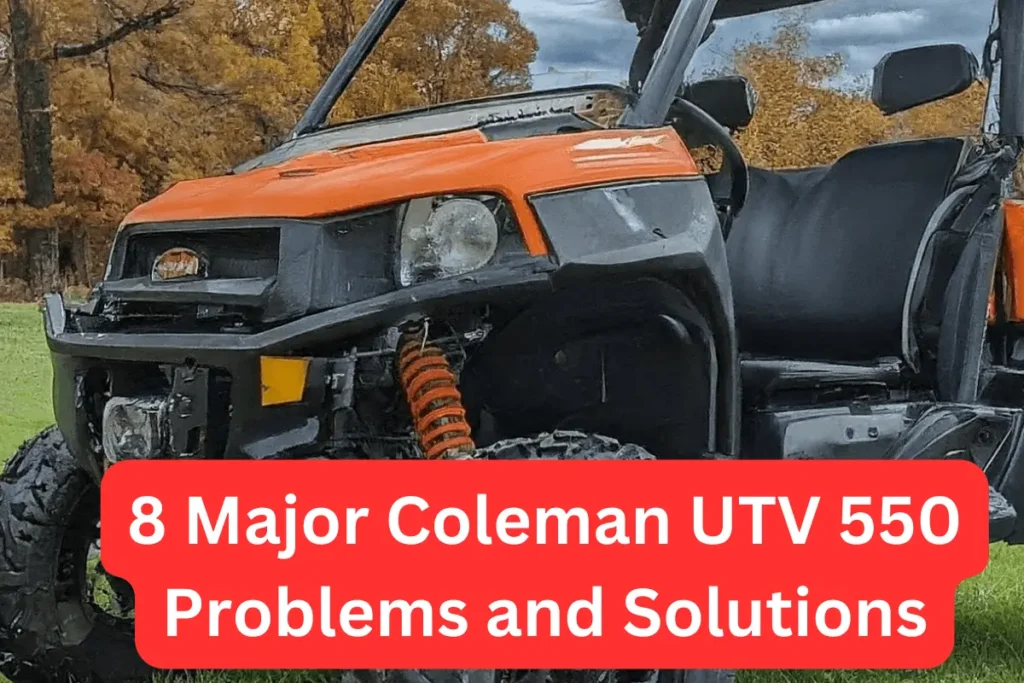The most common Polaris Sportsman 500 problems are starting issues, battery problems, brake issues, lights not working, shaky and noisy when idling, and struggling when accelerating.
Here we discuss in detail why these issues occur and also provide easy solutions to these problems.
Polaris Sportsman 500 Problems
Now we will discuss Polaris’s major problems along with their solutions.
1. Polaris Sportsman 500 starting problems

If you’re having trouble starting your Polaris Sportsman 500, there could be a few reasons behind it. Let’s go through some common issues and solutions to help you get back on the trail:
- Battery Issues: One of the most common reasons for starting problems is a weak or dead battery. Check the battery terminals to ensure they’re clean and securely connected. If the battery is old or not holding a charge, it might need to be replaced.
- Fuel Problems: If your ATV has been sitting unused for a while, old fuel or water contamination in the fuel tank can cause starting issues. Try draining the fuel tank and refilling it with fresh, clean fuel. You may also want to check the fuel filter for any blockages.
- Spark Plug Troubles: A faulty or worn-out spark plug can prevent your ATV from starting. If necessary, replace the spark plug if it shows signs of wear or damage. Additionally, check the spark plug wire for any damage or loose connections.
- Electrical Issues: Sometimes, starting problems can be caused by electrical issues such as a faulty ignition switch or starter solenoid. Inspect these components for any signs of damage or corrosion, and replace them if needed.
- Engine Compression: Low engine compression can also prevent your ATV from starting. If you’ve checked everything else and are still having problems, it might be worth having a mechanic perform a compression test to diagnose any underlying engine issues.
Also read Are Polaris Rangers Street legal?
2. Polaris Sportsman 500 battery problems
These issues can be frustrating, but understanding the common causes and potential solutions can help resolve them effectively.
One common problem users face is a dead or weak battery. This can occur due to several reasons, including improper maintenance, age, or excessive use of electronic accessories.
To address this issue, it’s essential to regularly check the battery’s condition, including its charge level and connections. Keeping the battery clean and properly charged can help prevent it from becoming depleted.
Another issue users may encounter is difficulty starting the ATV, especially in cold weather. This could be attributed to a weak battery or problems with the ATV’s electrical system.
In such cases, it’s advisable to check the battery’s voltage using a multimeter and make sure that it meets the manufacturer’s specifications. If the battery is low, recharging it or replacing it with a new one may be necessary to improve starting performance.
Additionally, users may experience issues with the ATV’s charging system, such as a faulty alternator or voltage regulator. A malfunctioning charging system can result in an undercharged battery, leading to recurring battery problems.
In such instances, it’s recommended to have the ATV inspected by a qualified mechanic to diagnose and repair any issues with the charging system.
To prevent future battery problems, users can also take proactive measures such as installing a battery tender or trickle charger when the ATV is not in use for extended periods. This helps maintain the battery’s charge and prolong its lifespan.
3. Struggling When Accelerating
One possible reason for this problem could be a clogged or dirty fuel filter.
Over time, dirt and debris can collect in the fuel filter, which can slow down the flow of fuel to the engine. This can result in poor acceleration and overall performance.
Thankfully, replacing the fuel filter is a relatively simple and inexpensive fix that can improve your ATV’s performance.
Another reason could be a dirty or fouled spark plug. A spark plug that is covered in carbon deposits or worn out can cause misfires, resulting in hesitation and poor acceleration. Replacing the spark plug with a new one can often resolve this issue and improve the engine’s performance.
Additionally, issues with the carburetor can also lead to acceleration problems. If the carburetor is dirty or out of adjustment, it can cause the engine to run lean or rich, resulting in poor acceleration and performance.
Cleaning the carburetor and adjusting it properly can help restore proper fuel delivery and improve acceleration.
It’s also essential to check the air filter regularly. A dirty or blocked air filter can limit the amount of air reaching the engine, which can result in less power and slower acceleration. Replacing the air filter with a clean one can improve airflow and restore your ATV’s performance.
Lastly, issues with the transmission or drive belt can also cause acceleration problems. If the drive belt is worn or damaged, it may slip or fail to engage properly, resulting in poor acceleration.
Similarly, problems with the transmission, such as low fluid levels or worn components, can also affect acceleration. In these cases, it’s best to have a professional mechanic inspect and repair the transmission or drive belt to ensure proper operation.
4. Shaky and Noisy When Idling
If your Polaris Sportsman 500 is shaky and noisy when idling, it could indicate a few potential issues that need attention. Let’s look into some typical reasons and solutions to assist you in fixing the issue:
- Dirty Air Filter: A dirty or clogged air filter can disrupt the air-fuel mixture in the engine, leading to rough idling and increased engine noise. Check the air filter and clean or replace it if necessary to ensure proper airflow to the engine.
- Faulty Spark Plug: A worn-out or faulty spark plug can cause misfires and erratic engine behavior, resulting in shaking and noise during idling. Inspect the spark plug for signs of wear or damage, and replace it if needed to restore smooth engine operation.
- Fuel Delivery Issues: Problems with fuel delivery, such as a clogged fuel filter or malfunctioning fuel pump, can cause fuel starvation and affect engine performance at idle. Check the fuel system components for any obstructions or malfunctions and address them accordingly.
- Engine Misalignment: If the engine mounts or bolts are loose or worn out, it can cause the engine to vibrate excessively and produce noise during idling. Inspect the engine mounts and bolts for any signs of damage or looseness, and tighten or replace them as necessary to ensure proper alignment.
- Exhaust System Leaks: Leaks or damage in the exhaust system can lead to increased engine noise and vibration, especially at idle. Check the exhaust system for any leaks, holes, or damaged components, and repair or replace them to eliminate the source of the noise and shaking.
- Idle Speed Adjustment: Incorrect idle speed settings can also contribute to shaky and noisy idling. Consult your owner’s manual or a professional mechanic to adjust the idle speed to the manufacturer’s specifications and ensure smooth engine operation.
- Engine Wear and Tear: Over time, normal wear and tear on engine components can lead to increased noise and vibration during idling. Regular maintenance, including oil changes, lubrication, and inspection of engine components, can help minimize wear and keep the engine running smoothly.
5. Lights Not Working
Let’s discuss common problems with the lights not working on a Polaris Sportsman 500. Here are some possible reasons and solutions to help you troubleshoot:
- Blown Fuse: The most common reason for lights not working is a blown fuse. Check the fuse box and replace any blown fuses with ones of the same rating. This should restore power to the lights.
- Faulty Bulbs: Sometimes, the issue may be as simple as a burnt-out bulb. Inspect the bulbs for any signs of damage or darkness. If a bulb is burnt out, replace it with a new one and test the lights again.
- Faulty Switch: A faulty switch can also cause the lights to stop working. Check the switch for any signs of damage or wear. If the switch is defective, it will need to be replaced to restore functionality to the lights.
- Bad Wiring Connections: Loose or corroded wiring connections can interrupt the flow of electricity to the lights. Inspect the wiring harness for any loose or damaged connections. Tighten or repair any connections as necessary to ensure proper electrical contact.
- Battery Issues: If the battery is low or not holding a charge, it may not provide enough power to the lights. Check the battery voltage using a multimeter and recharge or replace the battery if necessary.
- Stator or Regulator/Rectifier Malfunction: If the stator or regulator/rectifier is faulty, it may not be properly charging the battery or supplying power to the lights. Have these components tested by a professional and replace them if necessary.
- Faulty Light Relay: In some cases, the light relay may be faulty, preventing power from reaching the lights. Test the relay using a multimeter and replace it if it’s not functioning properly.
6. Brake Issues
If you’re experiencing brake issues with your Polaris Sportsman 500, it’s important to address them promptly for your safety and the longevity of your vehicle. Here’s a breakdown of common brake problems and some helpful tips:
- Brake Fade: If you notice that your brakes feel less responsive or weaker than usual, it could be due to brake fade. This occurs when the brake pads or discs become overheated, reducing their effectiveness. To prevent brake fade, avoid excessive braking on steep slopes or during heavy towing. Additionally, ensure that your brake system is properly maintained and that the brake fluid is at the correct level.
- Spongy Brake Pedal: A spongy or soft brake pedal can indicate air in the brake lines or a leak in the hydraulic system. Bleeding the brake lines to remove air bubbles can often resolve this issue. Check for any visible leaks in the brake lines, calipers, or master cylinder, and replace any damaged components as needed.
- Brake Noise: Unusual noises such as squealing, grinding, or clicking when applying the brakes may indicate worn brake pads or damaged brake components. Inspect the brake pads for wear and replace them if necessary. Additionally, check for any debris lodged between the brake pads and discs, as this can cause noise and reduce braking efficiency.
- Brake Dragging: If you notice that your Polaris Sportsman 500 feels sluggish or has reduced acceleration, it could be due to brake dragging. This occurs when the brake pads do not fully release from the discs, causing friction and resistance. Check for any obstructions or debris that may be preventing the brake pads from retracting fully. Adjust the brake calipers if necessary to ensure proper clearance between the pads and discs.
- Uneven Brake Wear: Uneven brake pad wear can lead to inconsistent braking performance and premature brake failure. Inspect the brake pads for signs of uneven wear and replace them if necessary. Ensure that the brake calipers are properly aligned and that the brake discs are free from any defects or damage.
- Loss of Braking Power: If you experience a sudden loss of braking power or if your brakes feel weak, it could indicate a problem with the brake system, such as a leak in the brake lines or a malfunctioning master cylinder. Inspect the brake system thoroughly and address any issues immediately to prevent accidents or further damage.
Conclusion:
As you see here we provide the complete details about the Polaris Sportsman 500 problems and their solutions. So solve these issues on time and enjoy your offroad journey.
You can also explore here the problems of the other models of Polaris Ranger.

